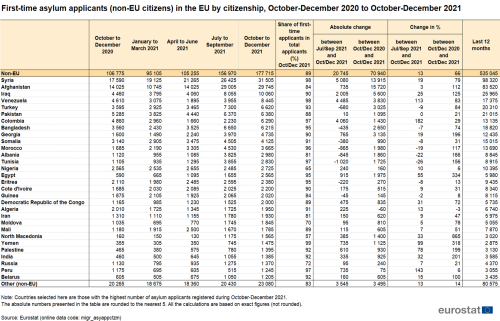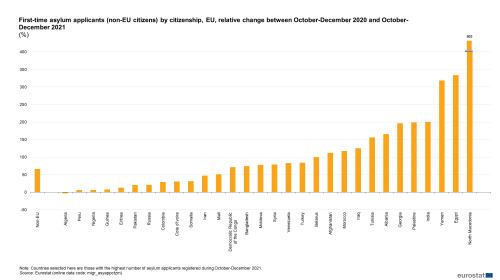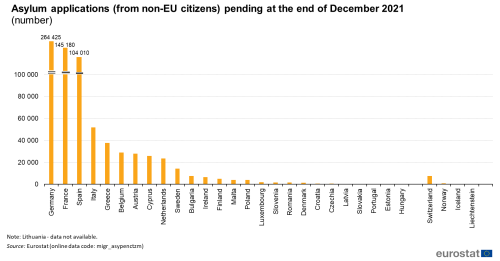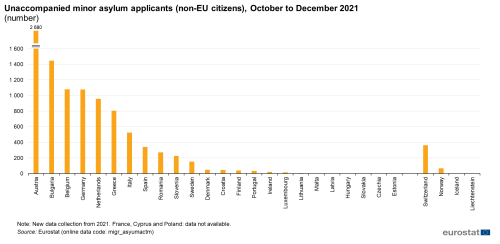Archive:Asylum quarterly report
This article has been archived. For information on migration and asyulum statistics please see Migration and asylum.
Data extracted on 23 March 2022.
No planned article update.
Highlights

(number)
Source: Eurostat (migr_asyappctzm)
This article describes recent developments in relation to the number of asylum applicants in the European Union (EU). Asylum is a form of international protection given by a state on its territory. It is granted to a person who is unable to seek protection in his/her country of citizenship and/or residence, in particular for fear of being persecuted for reasons of race, religion, nationality, membership of a particular social group, or political opinion.
The legal basis of the asylum data collection is Council Regulation (EC) No 862/2007. The amendment of this regulation adopted in June 2020 introduced additional new statistics and disaggregations. In addition, from the reference year 2021, Eurostat started to collect statistics on unaccompanied minors (subject to asylum applications, decisions at first instance and final decisions on appeal), on subsequent asylum applicants, on asylum applications under accelerated procedure, on applicants benefiting from material reception conditions and on types of withdrawal of asylum applications. Some of these new data are already presented in this article. In accordance with the amended Regulation, Member States could apply for specific derogations to provide new statistics for a period of up to three years. A complete list of such derogations is provided in the Commission Implementing Decision (EU) 2021/431. Due to the requested derogations, the new statistics are not yet complete for all Member States.
Due to the COVID-19 pandemic, and the related introduction of movement restrictions and border closures, some countries applied administrative measures (e.g. temporary closure of asylum authorities, suspension of asylum interviews, suspension of lodging applications), which resulted in a drop in the number of asylum applications as well as in the number of decisions issued, starting from March 2020. This can directly impact the growth rates when comparing data between 2021 and 2020, therefore data should be interpreted with caution.
Full article
Main trends in the number of asylum applicants
In the three month period from October to December 2021, there were around 177 700 first-time asylum applicants[1] (non-EU citizens) for international protection in countries of the EU. This was up 66 % when compared with the same period of the previous year, and up 13 % when compared with the previous quarter of 2021 (see Figure 1, Table 2).
The number of first-time asylum applicants in the EU accounted for a large majority (89 %) of the total number of asylum applicants[2] recorded in October to December 2021.
Additionally, starting from the reference year 2021, Eurostat collects statistics on subsequent asylum applicants. According to available data, there were 20 700 subsequent asylum applicants[3] recorded in the EU in October to December 2021. This was down 6.2 % when compared with the third quarter of 2021.

(number, %)
Source: Eurostat (migr_asyappctzm)
Where do asylum applicants come from?
Citizens of 138 countries, as well as stateless persons, sought asylum for the first time in the EU in October to December 2021. Syrian, Afghan and Iraqi were the top 3 citizenships of asylum seekers, lodging 31 500, 29 700 and 10 100 applications respectively (see Table 1).

In October to December 2021, among the 30 main citizenships, the most substantial increases in the number of asylum applicants compared with the same period of 2020 were recorded for Afghans, Syrians and Iraqis, followed by Venezuelans, Georgians and Turks. The number of asylum applicants decreased for citizens of Algeria (see Table 1).
The most substantial relative increase in the number of asylum applicants in the EU in October to December 2021, compared with the same period of 2020, was recorded for citizens of the Republic of North Macedonia, followed by Egyptians and Yemenites (see Figure 2, Table 1).

(%)
Source: Eurostat (migr_asyappctzm)
Where do asylum applicants go to?
The highest number of first-time asylum applicants in October to December 2021 was registered in Germany (with 46 700 first-time applicants, or 26 % of all first-time applicants in the EU Member States), followed by France (30 500, or 17 %), Spain (22 300, or 13 %), Italy (15 300, or 9 %) and Austria (15 000, or 8 %). These five Member States together account for nearly three quarters of all first-time applicants in the EU in the fourth quarter of 2021 (see Table 2).

The number of first-time asylum applicants increased in the majority of the countries in October to December 2021 compared with the same period of 2020. Germany was the country with the largest absolute increase in the number of first-time applicants, followed by Austria, France and Italy. By contrast, the number of first-time asylum seekers decreased in Romania, Malta, Czechia, Slovakia and Hungary (Table 2).
Lithuania, Poland, Ireland and Austria recorded the largest relative increases in first-time asylum seekers, whereas the largest relative decrease was observed in Malta (see Figure 3, Table 2).

(%)
Source: Eurostat (migr_asyappctzm)
In October to December 2021, Afghan was the main citizenship of asylum seekers in eight EU Member States, Syrian in six and Iraqi in two (see Table 3). Of the Afghans who applied for first time for asylum in the EU in the third quarter of 2021, 27 % were registered in Germany. Germany was also the main receiving country for Syrian (44% of all Syrians) and Iraqi asylum applicants (69 % of all Iraqis) (see Table 4).


Compared with the population of each Member State (on 1st January 2021), the highest rate of registered first-time applicants during the fourth quarter of 2021 was recorded in Cyprus (5 125 first-time applicants per million population), followed by Austria (1 678), Slovenia (972), Bulgaria (721) and Luxembourg (682). By contrast, the lowest rates were observed in Hungary (1 applicant per million population), Estonia (13), Slovakia (13), Czechia (22) and Latvia (33). In total in the EU as a whole, there were 398 first-time asylum applicants per million population in October to December 2021 (see Table 2).
In 2021, Eurostat started to collect new data on asylum applications under an accelerated procedure[4]. According to available data, the highest number of such applications in October to December 2021 was registered in France (10 900), followed by Austria (5 800) and Italy (3 100). More than 100 asylum applications were also processed under an accelerated procedure in the Netherlands and Czechia (see Figure 4).

(number)
Source: Eurostat (migr_asyaccm)
Pending applications
Pending applications for international protection are those that have been made at any time and are still under consideration by the relevant national authorities at the end of the reference period. In other words, they refer to the “stock” of applications for which decisions are still pending.
At the end of December 2021, 758 700 applications for asylum protection in the EU Member States (missing data for Lithuania) were under consideration by the national authorities. With 264 400 pending applications at the end of December 2021, Germany had the largest share in the EU (35 % of the EU total), ahead of France (145 200, or 19 %) and Spain (104 000, or 14 %)(see Figure 5).

(number)
Source: Eurostat (migr_asypenctzm)
Applications by unaccompanied minors
An unaccompanied minor is a person less than 18 years old who arrives on the territory of an EU Member State not accompanied by an adult responsible for the minor or a minor who is left unaccompanied after having entered the territory of a Member State. Since 2021, Eurostat collects more information on unaccompanied minors on a monthly (from January 2021), quarterly (from Q1 2021) and annual (from 2021 reference year) basis. Data for previous periods were collected on a voluntary basis and therefore some information on unaccompanied minors may be also available in the Eurostat database.
In October to December 2021, according to the available monthly data, the highest number of unaccompanied minors was registered in Austria (2 700), followed by Bulgaria (1 400) and Belgium and Germany (1 100 each) (see Figure 6).

(number)
Source: Eurostat (migr_asyumactm)
Data sources
The data used for this publication are provided to Eurostat by the interior and justice ministries or immigration agencies of the Member States and EFTA countries. Data on asylum applications are collected monthly. They are based entirely on relevant administrative sources and supplied in accordance with the provisions of Article 4 of the Regulation (EC) No 862/2007 of 11 July 2007 on Community statistics on migration and international protection. All data presented in this publication are rounded to the nearest 5, and are provisional (except where otherwise stated) and may be subject to change.
Context
The Directorate-General Migration and Home Affairs (DG HOME) is responsible for developing EU policies on asylum.
The 1951 Geneva Convention relating to the status of refugees (as amended by the 1967 New York Protocol) has, for over 60 years, defined who is a refugee, and laid down a common approach towards refugees that has been one of the cornerstones for the development of a common asylum system within the EU.
Since 1999, the EU has been working towards creating a common European asylum regime in accordance with the Geneva Convention and other applicable international instruments. A number of directives in this area have been developed. The four main legal instruments on asylum are:
- the Qualification Directive 2011/95/EU on standards for the qualification of non-EU nationals and stateless persons as beneficiaries of international protection, for a uniform status for refugees or for persons eligible for subsidiary protection;
- the Asylum Procedures Directive 2013/32/EU on common procedures for granting and withdrawing international protection;
- the Reception Conditions Directive 2013/33/EU laying down standards for the reception of applicants for international protection;
- the Dublin Regulation (EU) No 604/2013 establishing the criteria and mechanisms for determining the Member State responsible for examining an application for international protection lodged in one of the Member States by a third-country national or stateless person.
The Hague programme was adopted by heads of state and government on 5 November 2004. It puts forward the idea of a common European asylum system (CEAS), in particular, it raises the challenge to establish common procedures and uniform status for those granted asylum or subsidiary protection. The European Commission’s policy plan on asylum (COM(2008) 360 final) was presented in June 2008 which included three pillars to underpin the development of the CEAS:
- bringing more harmonisation to standards of protection by further aligning the EU Member States’ asylum legislation;
- effective and well-supported practical cooperation;
- increased solidarity and sense of responsibility among EU Member States, and between the EU and non-member countries.
In May 2010, the European Commission presented an action plan for unaccompanied minors (COM(2010) 213 final), who are regarded as the most exposed and vulnerable victims of migration. This plan aims to set up a coordinated approach and commits all EU Member States to grant high standards of reception, protection and integration for unaccompanied minors.
In December 2011, the European Commission adopted a Communication on ‘Enhanced intra-EU solidarity in the field of asylum’ (COM(2011) 835 final). This provided proposals to reinforce practical, technical and financial cooperation, moving towards a better allocation of responsibilities and improved governance of the asylum system in the EU, namely through:
- introducing an evaluation and early warning mechanism to detect and address emerging problems;
- making the supporting role of the EASO more effective;
- increasing the amount of funds available and making these more flexible, taking into account significant fluctuations in the number of asylum seekers;
- developing and encouraging the relocation of beneficiaries of international protection between different EU Member States.
In September 2020, the European Commission presented the New Pact on Migration and Asylum. This pact provides a comprehensive approach, bringing together policy in the areas of migration, asylum, integration and border management, recognising that the overall effectiveness depends on progress on all fronts. It creates faster, seamless migration processes and stronger governance of migration and borders policies, supported by modern IT systems and more effective agencies. It aims to reduce unsafe and irregular routes and promote sustainable and safe legal pathways for those in need of protection. It reflects the reality that most migrants come to the EU through legal channels, which should be better matched to EU labour market needs.
On 4 March 2022, the Council unanimously adopted the implementing decision introducing temporary protection due to the mass influx of persons fleeing Ukraine as a consequence of the war. The activated Temporary Protection Directive provides special procedures to deal with mass influxes of displaced persons for the first time. Temporary protection is an exceptional measure to provide immediate and temporary protection to displaced persons from non-EU countries and those unable to return to their country of origin. It applies when there is a risk that the standard asylum system is struggling to cope with demand stemming from a mass influx risking a negative impact on the processing of claims. Requirements for reporting such statistics already exist in Article 4(1)(c) and 4(3)(e) of Regulation (EC) No 862/2007. Practically, they shall be implemented for the first time with the transmission of data on international protection as follows: quarterly data for the first quarter of 2022 are due by 31 May 2022 and annual data for the year 2022 - by 31 March 2023. The data on temporary protection for the first quarter of 2022 will be released by Eurostat in June 2022.
Direct access to
- Asylum (t_migr_asy), see:
- Asylum and new asylum applicants - monthly data (tps00189)
- Persons subject of asylum applications pending at the end of the month - monthly data (tps00190)
- Asylum and new asylum applicants - annual aggregated data (tps00191)
- First instance decisions on applications by type of decision - annual aggregated data (tps00192)
- Final decisions on applications - annual data (tps00193)
- Asylum applicants considered to be unaccompanied minors - annual data (tps00194)
- Resettled persons - annual data (tps00195)
- Asylum (migr_asy), see:
- Applications (migr_asyapp)
- Asylum and first time asylum applicants by citizenship, age and sex Annual aggregated data (rounded) (migr_asyappctza)
- Asylum and first time asylum applicants by citizenship, age and sex Monthly data (rounded) (migr_asyappctzm)
- Persons subject of asylum applications pending at the end of the month by citizenship, age and sex - Monthly data (rounded) (migr_asypenctzm)
- Asylum applications withdrawn by citizenship, age and sex Annual aggregated data (rounded) (migr_asywitha)
- Asylum applications withdrawn by citizenship, age and sex - Monthly data (rounded) (migr_asywithm)
- Asylum applicants having had their applications processed under the accelerated procedure, by age, sex and citizenship - monthly data (rounded) (migr_asyaccm)
- Unaccompanied minor asylum applicants by type of applicant, citizenship, age and sex - monthly data (rounded) (migr_asyumactm)
- Asylum applicants considered to be unaccompanied minors by citizenship, age and sex Annual data (rounded) (migr_asyunaa)
- Unaccompanied minors subject of asylum applications pending at the end of the month by citizenship, age and sex - monthly data (rounded) (migr_asyumpctm)
- Unaccompanied minors subject of asylum applications pending at the end of the month by citizenship, age and sex - monthly data (rounded) (migr_asyumpctm)
- Unaccompanied minor asylum applicants having had their applications processed under the accelerated procedure, by age, sex and citizenship - monthly data (rounded) (migr_asyumaccm)
- Applications (migr_asyapp)
- Decisions on applications and resettlement (migr_asydec)
- First instance decisions on applications by citizenship, age and sex Annual aggregated data (rounded) (migr_asydcfsta)
- First instance decisions on applications by citizenship, age and sex Quarterly data (rounded) (migr_asydcftq)
- Decisions withdrawing status granted at first instance decision by type of status withdrawn and by citizenship Annual aggregated data (rounded) (migr_asywitfsta)
- Decisions withdrawing status granted at first instance decision by type of status withdrawn and by citizenship Quarterly data (rounded) (migr_asywitfstq)
- Final decisions on applications by citizenship, age and sex Annual data (rounded) (migr_asydcfina)
- Decisions withdrawing status granted as final decision by type of status withdrawn Annual data (rounded) (asywitfina)
- Resettled persons by age, sex and citizenship Annual data (rounded) (migr_asyresa)
- First instance decisions on applications of unaccompanied minors by citizenship, age and sex - quarterly data (rounded) (migr_asyumdcfq)
- Decisions withdrawing status granted at first instance decision to an unaccompanied minor by type of status withdrawn, citizenship and reason - quarterly data (rounded) (migr_asyumwifq)
- Decisions on applications and resettlement (migr_asydec)
- Applications (migr_asyapp) (ESMS metadata file — migr_asyapp_esms)
- Decisions on applications and resettlement (migr_asydec) (ESMS metadata file — migr_asydec_esms)
Legislation
- the Qualification Directive 2011/95/EU on standards for the qualification of non-EU nationals and stateless persons as beneficiaries of international protection, for a uniform status for refugees or for persons eligible for subsidiary protection (Summary)
- the Asylum Procedures Directive 2013/32/EU on common procedures for granting and withdrawing international protection (Summary)
- the Reception Conditions Directive 2013/33/EU laying down standards for the reception of applicants for international protection (Summary)
- the Dublin Regulation (EU) No 604/2013 establishing the criteria and mechanisms for determining the Member State responsible for examining an application for international protection lodged in one of the Member States by a third-country national or stateless person
Notes
- ↑ A first-time applicant for international protection is a person who lodged an application for asylum for the first time in a given Member State. The indicator 'First-time asylum applicants' excludes repeated applicants, i.e. persons applying for asylum more than once in one country, and therefore more accurately presents the number of persons applying for international protection in the EU Member States. The use of this indicator is possible as all Member States have been able to provide it to Eurostat since 2014.
- ↑ The indicator 'Total asylum applicants' includes first-time and repeated asylum applicants.
- ↑ Subsequent application for international protection is an application as defined in Article 40 of Directive 2013/32/EU. A person subject to subsequent application is one who made a further application for international protection after a final decision (positive/negative/discontinuation) has been taken on a previous application, including cases where the applicant has explicitly withdrawn his or her application and cases where the determining authority has rejected an application following its implicit withdrawal.
- ↑ 'An asylum applicant having had their application processed under the accelerated procedure' means a person having submitted an application for international protection or having been included in such an application as a family member during the reference period and having had their applications processed under the accelerated procedure provided for in Article 31(8) of Directive 2013/32/EU (see Art.4.1(e) of the Regulation), if such a procedure is foreseen in the national legislation of the reporting country. It refers to the number of applicants the country has processed - at first instance - under an accelerated procedure during the reference month, regardless of the date of application and of the outcome of the procedure (rejection of the application or grant of a protection status).